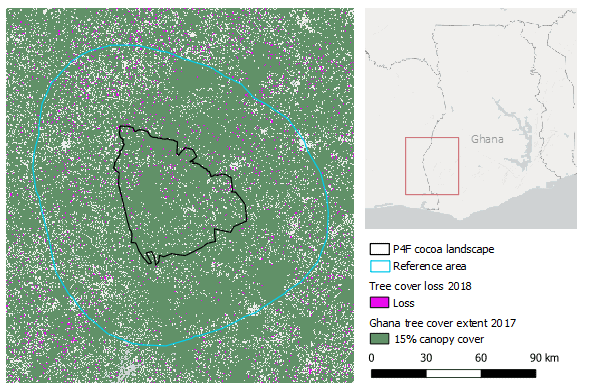Partnerships for Forests needed a fast, flexible, and cost-effective methodology for assessing its forest carbon impacts. Here’s how it works.

Tropical deforestation accounts for more carbon emissions than the sum of all the cars and trucks on the road around the world. Addressing emissions in this sector is critical in tackling the climate crisis. Especially critical, in fact, as forest and land use change is the only source of carbon emissions that has the potential to become a sink.
The Partnerships for Forests (P4F) programme was established in recognition of the crucial role that protecting forests and reducing deforestation has in reaching our global climate goals. As our portfolio of regenerative business models – now spanning over 22 countries – started to grow, it was important for us to create a reliable way of tracking our carbon impact and measuring our performance.
To do that we developed a simple, rapid, desk-based methodology that estimates carbon impact resulting from change in forest cover at the project level. The methodology can estimate both the projected and observed impact of our projects, and allows us to understand our impact across the diverse landscapes in our portfolio – from the Amazon to the Ethiopian highlands.
Here, we share our approach, validated by an external third party, for other project developers to apply to their own portfolios.
Using carbon assessments for decision support and impact monitoring
The world of forest carbon monitoring is a complicated one; many different forest and land use projects and businesses conduct various in-depth forest carbon assessments. They are generally used only for compliance or for generating voluntary credits, but carbon assessments can be valuable much more broadly if used for monitoring impact and informing decisions.
Monitoring performance is a critical part of developing sustainable forest and land use solutions; we need to evaluate whether our interventions are achieving the impact intended, understand which of our models work and clearly quantify the impact we’re having.
The P4F method: a fast, flexible, desk-based approach to assessing carbon impact
Our carbon assessment methodology is designed to be quick, and easily applicable to different landscapes and project types in tropical forest regions. Rather than creating an alternative to certified voluntary standards or adding to Nationally Determined Contributions (NDCs) achievements, we intended it to provide a reliable indicative assessment of the forest carbon impact of P4F-supported interventions.
There are two methodologies in the approach: one for avoided deforestation and one for reforestation. Both ex-ante (projections) and ex-post (observed) estimates can be made using the approach.
Forest focused
With P4F providing support to forest-friendly businesses, an appropriate scope for our assessments is tree cover change. Carbon cycles in the natural world are complex and almost every stage of a product or commodities’ life cycle has a carbon impact. In the case of major commodities like palm oil, rubber and cocoa, evidence suggests that land use change and deforestation are responsible for the main chunk of their emissions. Our carbon assessments therefore estimate the carbon impact of a project based on how it affects change in forest cover.
Aligned with best practice
There are two main parts of the P4F forest carbon assessment approach. First is the tool we selected: the Food and Agriculture Organisation’s (FAO) EX-ACT tool. Second, the methodology we use to generate the data.
The FAO’s EX-ACT tool is Excel-based and uses a series of formulae and default data for estimating carbon stock fluxes from a range of land use changes. We selected this tool because of its simplicity and flexibility; complexity of analysis can be scaled up or down according to the data available.
Formulae and methodologies for calculating forest cover under different scenarios developed by the scientific community have been integrated into verified carbon accounting standards. The methodology used in our carbon assessments is aligned with the ICF KPI6 guidelines (UK Government climate programme guidelines) and draws on aspects of Verified Carbon Standard (VCS) and Clean Development Mechanism (CDM) methodologies.
A rapid tool for a dynamic programme
The approach is designed to be as rapid as possible. We manage a diverse portfolio, screening hundreds of projects that might be approved initially but dropped at a later stage. So we needed a tool for understanding the potential carbon impact of a project quickly and without requiring significant upfront investment.
The approach we devised requires minimal input data. In the case of avoided deforestation assessments, our partners need only provide the boundaries of their project (a shapefile) and answer nine questions to assess how project activities might reduce the risk of deforestation. If projects are unable to provide exact boundaries, we can approximate ones on their behalf. An analyst can extract the location-specific data using the project boundaries in under 30 minutes with GIS systems.
Desk-based approach to generating location-specific data
One of the major costs of producing a project-based forest carbon assessment is the generation of location-specific data. This would usually require specialists heading out into the field, but advances in technology are helping to bring these costs down.
Governments and academic institutions around the world have made satellite derived spatial data (e.g. land cover) freely available and an increasing amount of open source software, such as QGIS, is available to process and analyse the data. Platforms such as Global Forest Watch also offer free access and analysis of datasets relevant to the forest and land use sector without requiring specialist training.
The P4F approach uses freely available spatial datasets and data analysis using open source GIS software (QGIS) to extract location specific data, saving time and money.
Understanding our potential impact and observing performance
The P4F approach to carbon assessments has helped us understand our impact potential at both the portfolio and project levels.

Our carbon assessment showed increased deforestation in the pilot project area (outlined in black), but less than in the surrounding reference area. We could conclude that project activities had successfully mitigated deforestation pressures.
Portfolio-wide, our ex-post assessments showed that six projects had achieved emission reductions of over 3 million tons of CO2 equivalent in 2018, indicating that project activities had been effective in reducing deforestation (though the methodology does not analyse other contributory factors). These projects have been in the P4F portfolio the longest and therefore any results are likely to be (at least partly) attributable to P4F’s involvement.
At the project-level, our assessments have been an important consideration in major decisions. Many initiatives we support have ambitious targets, often in challenging contexts where chronic deforestation pressures are prevailing or even increasing. In 2018, analysis by WRI showed that deforestation had increased in Ghana’s cocoa landscapes where P4F-supported projects operate – this initially raised concerns while assessing one of our pilots. However, the ex-post analysis showed that although there was increased deforestation in the project area, it was less than in the surrounding reference area. This result confirmed that project activities had mitigated the increased deforestation pressures, so we could declare the pilot successful and ready to scale-up.
A suite of tools for a low carbon future
The climate crisis is a time-critical one. We need tools that can help us quickly understand the likelihood that new interventions will work and assess whether they are performing as expected within the local context. Though it does not replace compliance systems or produce voluntary carbon credits, using carbon assessments to support decision making and impact monitoring has proven invaluable for us at P4F.
Our carbon assessment methodology is open-source and available here – we hope other project developers and similar funds can use it to understand their performance.
